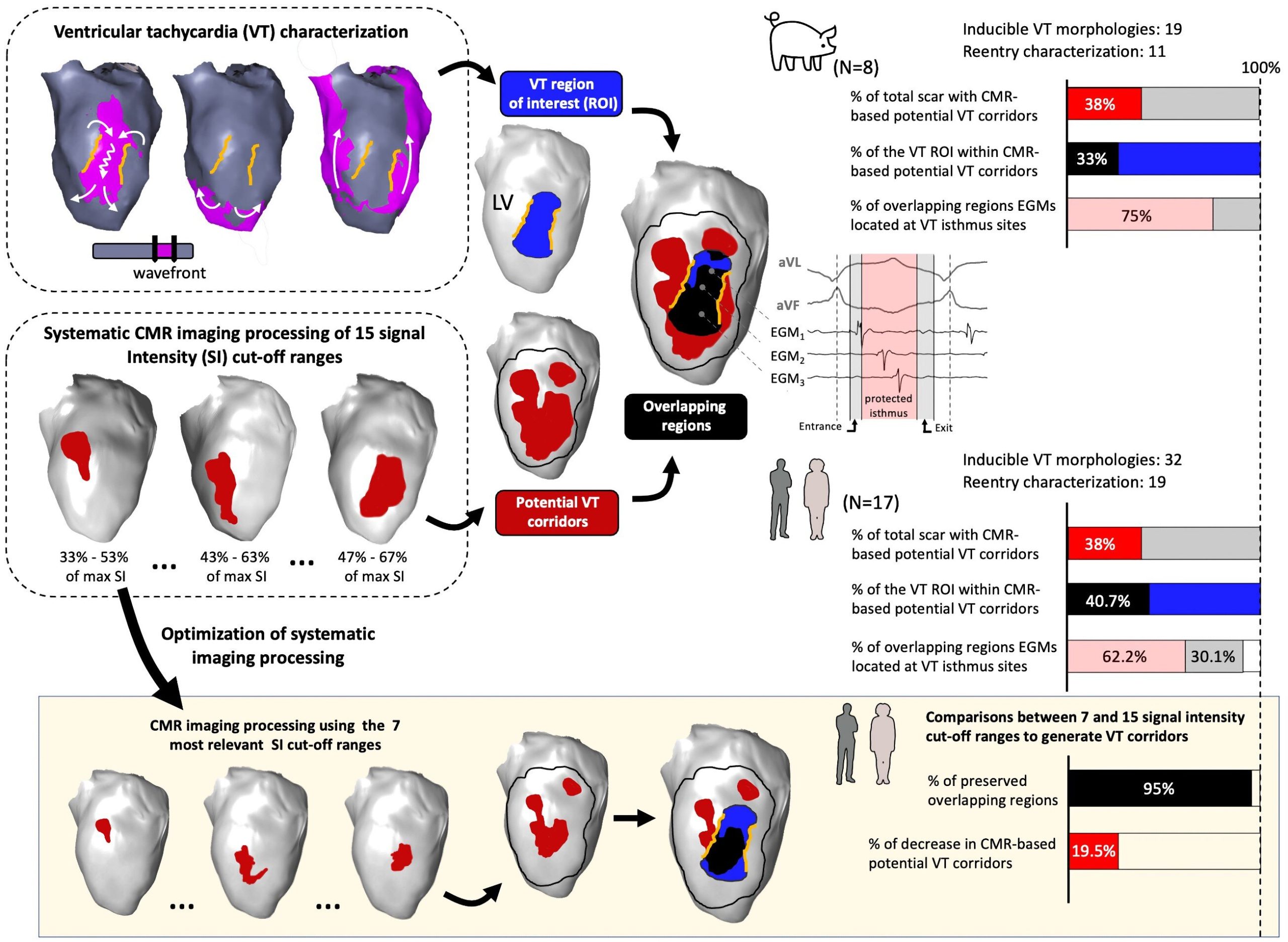
A multicenter study has described and validated a new strategy for guiding ablation procedures in patients with complex tachycardias. Ablation procedures use energy—usually heat or cold—to eliminate small areas of heart tissue that cause pathological cardiac arrhythmias, thereby restoring normal heart rhythm. This type of procedure is frequently used to treat ventricular tachycardias originating in areas affected by scarring after a myocardial infarction.
The study was led by researchers at Hospital Clínico San Carlos and the Centro Nacional de Investigaciones Cardiovasculares in Madrid. Also participating in the study were teams at Hospital Universitario de la Paz in Madrid, Hospital Clínic de Barcelona, and Maastricht University Medical Center in The Netherlands, as well as members of the Spanish cardiovascular research network (CIBERCV).
The study is published in Europace.
The new approach uses advanced methods for processing cardiac magnetic resonance (CMR) images to identify the areas that maintain ventricular tachycardia in heart regions affected by postinfarction scarring. The method allows images to be processed systematically, avoiding the biases that can arise when CMR imaging parameters are selected manually. This systematic image processing increases the sensitivity for the detection of the regions responsible for these types of arrhythmia.
Moreover, the new strategy supports preoperative planning by allowing operators to accurately detect these regions before starting the ablation procedure.
The study used a swine model of myocardial infarction to analyze how variability in image processing parameters impedes accurate detection of the cardiac tissue circuits that maintain complex ventricular tachycardias. Using this animal model, the researchers designed a strategy that avoids this problem, and the method was later validated in patients in a multicenter study conducted between 2013 and 2022 and involving leading national and international experts.
Study coordinator David Filgueiras, a CNIC group leader, cardiologist at the Instituto de Investigación Sanitaria del Hospital Clínico San Carlos, and CIBERCV member, explained, “The study helps to fill gaps in the integration of imaging data during the planning of ablation procedures for ventricular tachycardia. By allowing personalized and unbiassed preprocedure planning, the new method can reduce procedure times and complications, which is especially useful in patients with severe and poorly tolerated episodes.
“The strategy achieves a high success rate without the need for invasive catheter mapping procedures, which in any case are frequently contraindicated by the patient’s clinical condition.”
The new image processing strategy simplifies the visualization of cardiac tissue at different depths, enabling an objective assessment of the cardiac wall and eliminating operator bias in the selection of imaging parameters for the detection of the myocardial regions responsible for infarct-related ventricular tachycardia.
Study co-author Nicasio Pérez-Castellano, head of the Arrhythmia Unit at Hospital Clínico San Carlos and a CIBERCV member, commented, “By reducing operator dependency and variability in the selection of imaging parameters, this approach resolves the lack of consensus about how to process CMR images to guide ablation procedures. With the systematic strategy developed in this study, we have demonstrated that it is possible to eliminate the biases associated with selection of imaging parameters.”
The simplified planning of ablation procedures with the new method is especially useful in patients for whom conventional invasive catheter mapping is contraindicated due to the risk of inducing more severe tachycardias and circulatory collapse. In place of these risky procedures, the new method uses cardiac images obtained before the ablation procedure to identify target areas without the need to induce tachycardia during the procedure, reducing risk without reducing efficacy.
Study co-author Julián Pérez Villacastín, head of the cardiology service at Hospital Clínico San Carlos, CIBERCV researcher, and a member of the Fundación Interhospitalaria para Investigación Cardiovascular (FIC), noted, “The conventional strategies used to characterize regions causing postinfarction ventricular tachycardia require invasive catheter mapping, a risky process that increases the time needed for the ablation procedure. The new approach identifies the culprit areas during preoperative planning and offers a standardized and unbiased method, allowing medical professionals in different centers to carry out ablations in a more controlled manner in highly complex patients.”
First author Alba Ramos Prada, a predoctoral researcher at the CNIC and a member of the FIC, emphasized, “The use of this systematic strategy to process CMR images and guide ablations in patients with ventricular tachycardia standardizes the imaging parameters, which are usually subjective in clinical practice.
“The proposed method creates a unified framework that eliminates several sources of variability, thereby improving image processing and procedure planning. The new strategy is highly applicable in the clinic and can be easily implemented in commercial systems currently used to guide the ablation of postinfarction ventricular tachycardias.”
More information:
Alba Ramos-Prada et al, Novel systematic processing of cardiac magnetic resonance imaging identifies target regions associated with infarct-related ventricular tachycardia, Europace (2024). DOI: 10.1093/europace/euae244
Provided by
Centro Nacional de Investigaciones Cardiovasculares Carlos III (F.S.P.)
Citation:
New strategy for cardiac MRI could aid in complex tachycardia treatment (2024, October 8)
retrieved 8 October 2024
from https://medicalxpress.com/news/2024-10-strategy-cardiac-mri-aid-complex.html
This document is subject to copyright. Apart from any fair dealing for the purpose of private study or research, no
part may be reproduced without the written permission. The content is provided for information purposes only.

